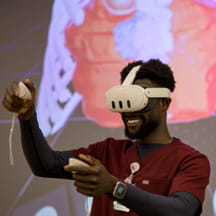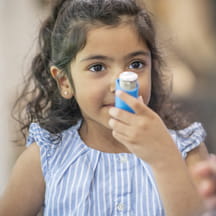
Every morning in the Ward Family Heart Center at Children’s Mercy Kansas City, you’ll find nurses watching videos of babies.
Not adorable TikToks or Instagram reels but homemade clips of vulnerable infants who are missing a ventricle from their heart.
They’re looking for subtle signs of deterioration: a change in skin color, irregular breathing, lethargic body language.
Infants with single ventricle congenital heart disease are some of the most medically fragile patients in pediatric care. The months between the first and second surgeries spent at home (called “interstage”) are especially dangerous, sometimes resulting in sudden death. A little over a decade ago, up to 20% of these patients died.
Children’s Mercy developed an app that allows nurses to keep tabs on the babies, and the survival rate rose to 98%. Over three years, the hospital had zero interstage deaths at home.
Watching closely, from a distance

Like many pediatric cardiology programs, Children’s Mercy had a home monitoring process in place before the CHAMP® app. Families were sent home with written instructions to track their baby’s weight, oxygen levels, and feeding. They scribbled notes in binders and brought them to clinic appointments every few weeks and sometimes discussed concerns over the phone.
But for babies with highly fragile hearts, the team knew they could do better.
“We wanted to see the data faster, and we wanted to be able to act on it,” said Lori Erickson, PhD, a nurse practitioner and director of Remote Health Solutions at Children’s Mercy.
CHAMP allows families to enter daily data and upload a short video of their baby. The entry fields can be customized for each family, and parents can leave comments about concerns. Before discharge, the Children’s Mercy team educates the family on how to enter data, what to look for, when to leave a note, and when to call.
Some categories include:
- Vital signs
- Feeding volumes
- Wet diapers
- Vomiting
- Weight
Nurses review the information every day. If the data looks concerning or something seems off in the video, they reach out. If a family doesn’t check in for a day or two, they follow up.
“That is one of the biggest reasons for success,” Erickson said. “There is always a nurse or nurse practitioner looking at that data proactively, not just reacting to an alert. In about half our red-flag cases, the family didn’t realize anything was wrong — we saw it before they did.”
The 15-second requirement for videos allows nurses to calculate the respiratory rate, which most families struggled with. And the visual cues provide another way to recognize signs of trouble.
“We’re involving that intuition you would get in the ICU that you can’t get from the data alone,” Erickson said.

Though these changes have resulted in a 2% mortality rate, Erickson emphasized nothing other than zero is acceptable. But the high survival rate has allowed them to improve other metrics like ICU days and readmissions.
“We’re sending more and more kids home that used to always stay at the hospital,” she said. “And that’s despite getting kids that are more and more complex.”
The app is available in 11 languages. Typically, socioeconomic differences are associated with worse outcomes in cardiology patients, but “that is not what we saw with CHAMP,” Erikson said. “It seems to have a protective support across socioeconomic drivers of health.”
For all the apps benefits, Erickson said it’s still only a tool.
“It's really the people that use it and how they use it is where the outcomes have continued to improve.”
With the success of the app, the hospital created another version to help babies wean from tube feeding. Outcomes improved substantially.
For all children’s hospitals
Today, CHAMP is used in nine children’s hospitals across the U.S. as part of a multi-site clinical research study. This is in addition to the over 10-year research repository that has included 12 hospitals and more than 1,500 babies.
The survival rate among CHAMP-enrolled patients is 97%, and outcomes have remained consistent across institutions even though many vary considerably in size, bed capacity, staffing, etc.
“This model works whether you’re a large cardiac center or a smaller hospital trying to improve outcomes for a handful of high-risk babies,” Erickson said. “It’s scalable, and it’s teachable.”
Children’s hospitals interested in using CHAMP can apply for enrollment in the research effort. Participation is currently limited to institutions enrolled in the clinical trial, but Erickson hopes to make CHAMP commercially available so all hospitals can use it in other care areas beyond cardiology.
For now, interested hospitals can email champapp@cmh.edu to learn more. The team offers guidance on study enrollment, data management, and care team training.
“Not every hospital is ready for this kind of model,” Erickson said. “But for those who are — especially if beds are full or patients are coming from far away — this is a way to extend care safely and effectively.”


